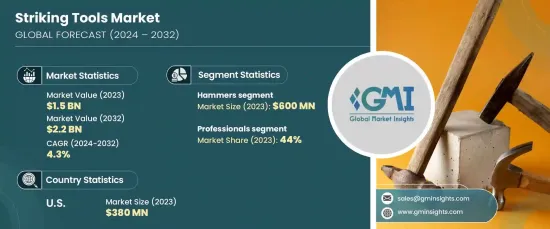
타격 용구 세계 시장은 2023년에 15억 달러에 달했으며, 2024년부터 2032년에 걸쳐 4.3%의 연평균 복합 성장률(CAGR)를 나타낼 것으로 예상되며 높은 성장세를 나타낼 것으로 예측됩니다.
이 성장의 원동력은 DIY와 주택 개수 프로젝트 수요 증가, 건설 및 인프라 부문의 활황, 자동차 및 항공 우주 산업의 확대입니다.

밀레니얼 세대와 Z세대는 DIY 프로젝트와 주택 개수에 대한 관심이 높아짐에 따라 박차를 가해 타격 도구 수요 증가의 주요 추진력이 되고 있습니다. 가정 수리 및 개선에 필수적인 핸드 툴에 대한 투자 증가도 시장 확대에 기여합니다. 게다가 가볍고 내구성이 뛰어나 인체공학을 바탕으로 설계된 첨단 타격 용구의 채용이 성장을 더욱 뒷받침하고 있습니다.
| 시장 범위 | |
|---|---|
| 시작연도 | 2023년 |
| 예측연도 | 2024년-2032년 |
| 시작금액 | 15억 달러 |
| 예측 금액 | 22억 달러 |
| CAGR | 4.3% |
타격 용구 시장은 제품 유형별로 망치, 픽 액스, 말렛, 치젤 펀치, 디거 등으로 구분할 수 있습니다. 2023년 6억 달러를 차지한 해머 분야는 2024년부터 2032년까지 연평균 복합 성장률(CAGR) 4.8%로 성장할 전망입니다. 피로, 진동, 부상의 위험을 줄이기 위해 고안된 인체공학을 기반으로 한 손잡이가 있는 고급 망치의 인기가 높아지고 있습니다. 건설이나 목공에서는 고무 당김 그립이나 충격 흡수 특성 등의 특징이 매우 선호되고 있습니다. 조정 가능한 헤드와 교체 가능한 부품을 갖춘 다목적 해머가 인기를 끌고 있으며 사용자에게 다용도를 제공합니다. 유리 섬유, 복합 핸들, 티타늄과 같은 가볍고 내구성있는 재료는 강도를 손상시키지 않고 사용 편의성을 보장하고이 분야 수요를 더욱 끌어 올리고 있습니다.
이 시장은 또한 최종 사용자별로 DIY 및 가정용, 프로용, 산업용으로 분류됩니다. 전문 분야는 2023년에 44% 시장 점유율을 차지하며, 2024년부터 2032년에 걸쳐 CAGR 4.7%를 나타낼 것으로 예측됩니다. 전문직은 장시간 타격 용구에 의지하는 경우가 많기 때문에 손의 부담을 경감하는 인간 공학에 근거한 설계나 방진 기능을 갖춘 공구가 강하게 요구되고 있습니다. 고무 미끄럼 방지 그립과 충격 흡수 핸들을 갖춘 제품은 특히 전문가들 사이에서 인기가 있으며 편안함을 향상시키고 부상을 예방합니다. 이러한 동향은 사용자의 편의성을 높일 뿐만 아니라 작업의 효율성과 정밀도를 향상시키고 이 분야 수요를 더욱 촉진하고 있습니다.
미국에서는 타격 용구 시장이 2023년에 3억 8,000만 달러로 평가되었으며, 2024년부터 2032년까지 연평균 복합 성장률(CAGR) 4.5%를 기록할 것으로 예상됩니다. 이 성장은 건설 및 인프라 부문의 번영, DIY 및 홈 센터 활동 증가, 기술 진보, 전문 사용자 수요 증가에 기인합니다. 공구의 내구성, 쾌적성, 기능성이 중시되고 미국 시장은 향후 10년간 계속 확대될 전망입니다.
The Global Striking Tools Market reached USD 1.5 billion in 2023 and is projected to grow at a robust CAGR of 4.3% from 2024 to 2032. This growth is driven by the rising demand for DIY and home improvement projects, a booming construction and infrastructure sector, and the expanding automotive and aerospace industries.

Millennials and Gen Z are key drivers in the rising demand for striking tools, spurred by their growing interest in DIY projects and home renovations. Increased investments in essential hand tools for household repairs and improvements are also contributing to the market's expansion. Additionally, the introduction of advanced striking tools that are lighter, more durable, and ergonomically designed is further fueling growth.
| Market Scope | |
|---|---|
| Start Year | 2023 |
| Forecast Year | 2024-2032 |
| Start Value | $1.5 Billion |
| Forecast Value | $2.2 Billion |
| CAGR | 4.3% |
The striking tools market can be segmented by product type into hammers, picks and axes, mallets, chisels and punches, diggers, and others. The hammers segment, which accounted for USD 600 million in 2023, is expected to grow at a CAGR of 4.8% during 2024 - 2032. Advanced hammers, with ergonomic handles designed to reduce fatigue, vibrations, and injury risks, are becoming increasingly popular. In construction and woodworking, features like rubberized grips and shock-absorbing properties are highly favored. Multi-purpose hammers with adjustable heads or interchangeable parts are gaining traction, offering versatility to users. Lightweight yet durable materials, such as fiberglass, composite handles, and titanium, ensure ease of use without compromising strength, further driving the demand for this segment.
The market is also categorized by end user into DIY and homeowners, professionals, and industrial sectors. The professionals segment held a 44% market share in 2023 and is anticipated to grow at a CAGR of 4.7% between 2024 and 2032. Professionals often rely on striking tools for extended periods, making ergonomic designs that reduce hand strain and tools with anti-vibration features highly sought after. Products with rubberized, non-slip grips and shock-absorbing handles are particularly popular among professionals, offering improved comfort and injury prevention. These trends not only enhance user comfort but also improve efficiency and precision in their work, further fueling the demand in this segment.
In the U.S., the striking tools market was valued at USD 380 million in 2023 and is forecast to grow at a CAGR of 4.5% from 2024 to 2032. This growth can be attributed to the thriving construction and infrastructure sectors, an increase in DIY and home improvement activities, technological advancements, and rising demand from professional users. With a growing emphasis on tool durability, comfort, and functionality, the U.S. market is poised to continue its expansion well into the next decade.